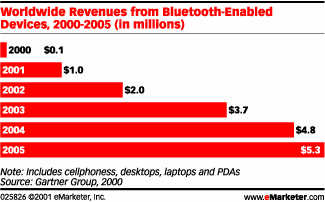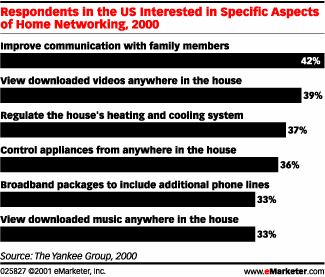 |
|
|
|
Wireless standard's sexy, cool nickname "Bluetooth" apparently comes from the 10th century Viking King Harald Bluetooth, who united Nordic nations under one religion. Bluetooth's namesake unites wireless products by transmitting signals between electronic devices such as cellphones, personal digital assistants (PDAs) and other appliances, which enables them to "talk" to each other. In essence, Bluetooth uses short-range radio links (up to 30 feet) at data transmission speeds up to 720kbps within the 2.4gigahertz (GHz) band. The technology has many advantages: it is always on, does not require line of sight or conscious intervention by the user and it is adaptable to any wireless standard. In addition it draws little power, making it a useful technology for battery-powered devices like mobile phones, laptops and PDAs. It allows devices to update each other automatically, so a new phone number programmed into a mobile phone is automatically added to a PDA or laptop. In a home networking environment, by using Bluetooth a single broadband connection to the home can be enhanced so that internet appliances within the household can communicate with each other without the need for additional cabling. Bluetooth's less sexy cousin -- 802.11 b (also known as Wi-Fi) has also caught the industry's fancy. Both technologies allow consumers to tap wirelessly into standard networks. The infrastructure for 802.11b, however, is much further along and transmission speeds within the 2.4GHz band are estimated at 11Mbps. Another factor in its favor is that 802.11b depends upon the same networking protocols and standards as traditional networking, so adaptation should be fairly easy. Frost & Sullivan (F&S) reports that by 2006, global sales of 2.4GHz wireless LAN products will reach $1.3 billion. F&S also reports that the telecom, computing and networking companies' consortium, Bluetooth Special Interest Group, will generate $2.3 billion in global revenue by 2006. Research firm Allied Business Intelligence estimates that manufacturers will ship 1.4 billion Bluetooth products in 2005, which is considerably more than its 20.2 million estimate for Wi-Fi shipments Gartner's estimates for revenues for Bluetooth-enabled devices peg revenues to reach only $5.3 million by 2005.
Frost & Sullivan reports that global shipments of Bluetooth-enabled products will total 11 million in 2001, equaling $2.5 million in revenues. The home networking market is forecast to grow strongly over the next five years and short-range wireless solutions such as Bluetooth will play an important role in its growth. According to The Yankee Group, 12.4 million US households will adopt home networking capabilities over the next year. How will households utilize their more wired homes? According to the Yankee Group the home network will provide a number of attractions.
Bluetooth-enabled appliances and services are beginning to emerge after a number of years of hype. Prices, however, are still quite steep. Sunderland Technologies' new Bluetooth adapter for Palm handhelds, costs $320. Bluetooth is an excellent development in wireless technology, as is i-mode, WAP and the plethora of other established and emerging wireless technologies. At times though, the wireless industry seems to focus on the technologies themselves rather than on what is really important for both business and consumer subscribers -- services and solutions. Does this technology provide a solution to communication and entertainment needs? Are the wireless services provided going to make my business more efficient and my life more enjoyable? These are the questions that need to be answered in order to determine how successful Bluetooth will ultimately be.
|
|||||


